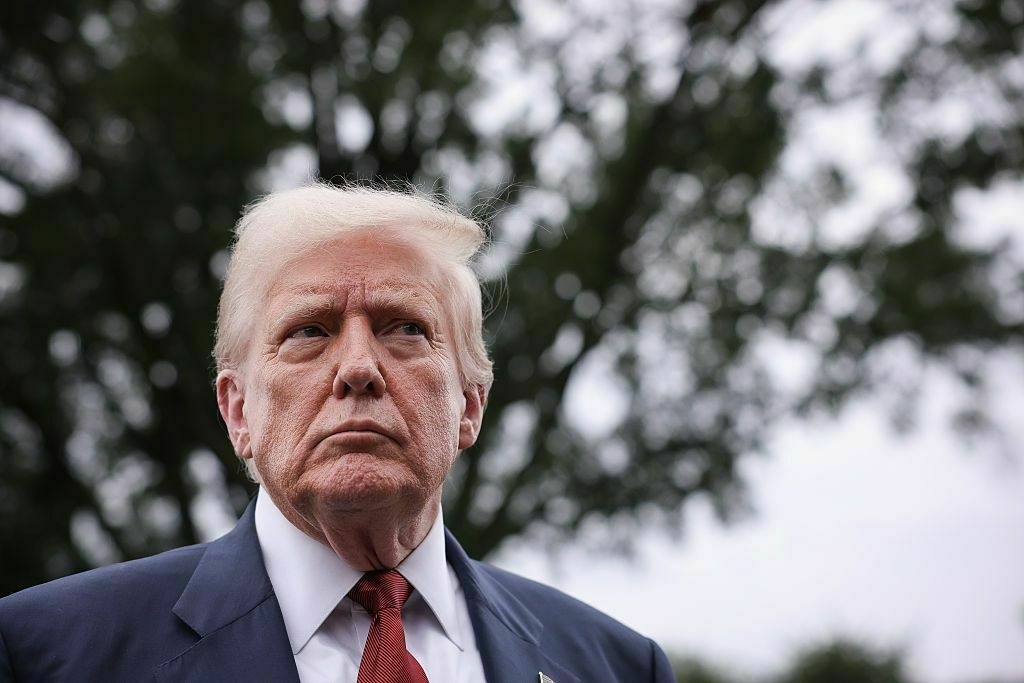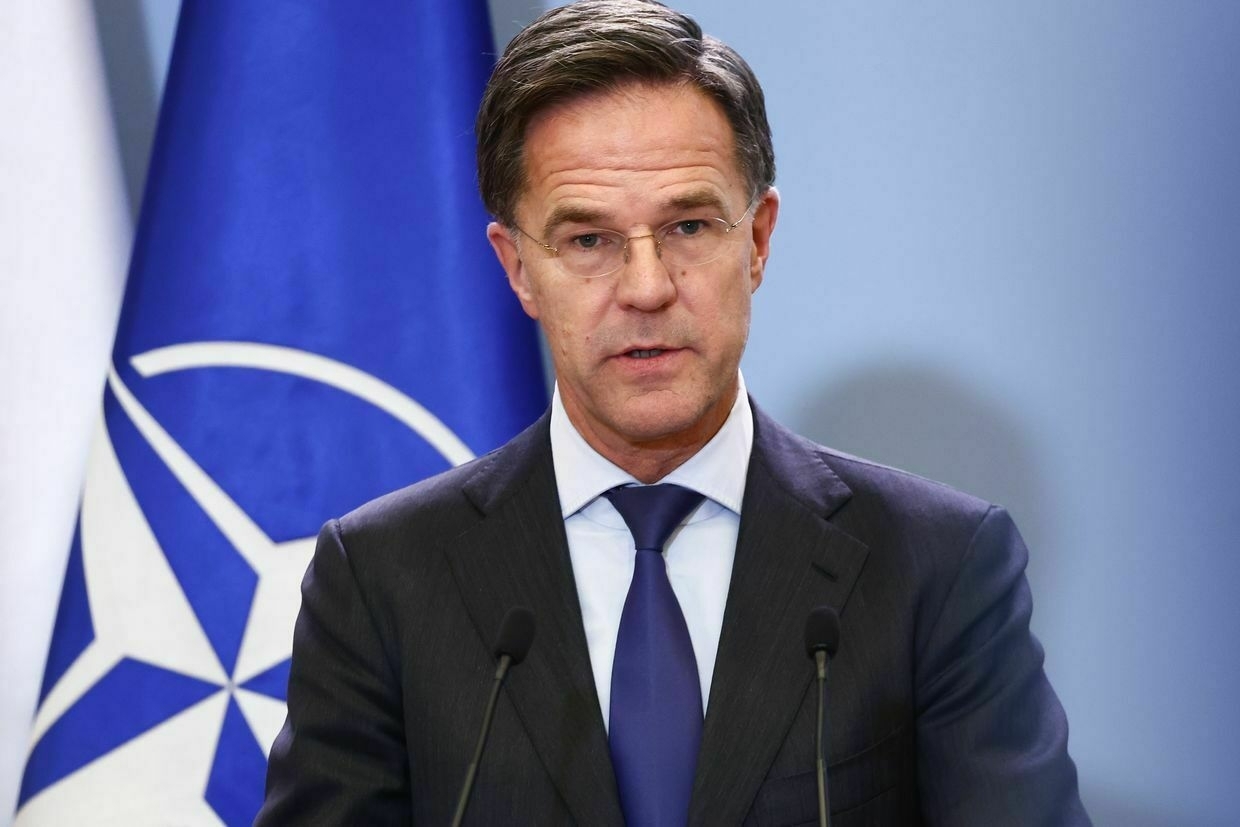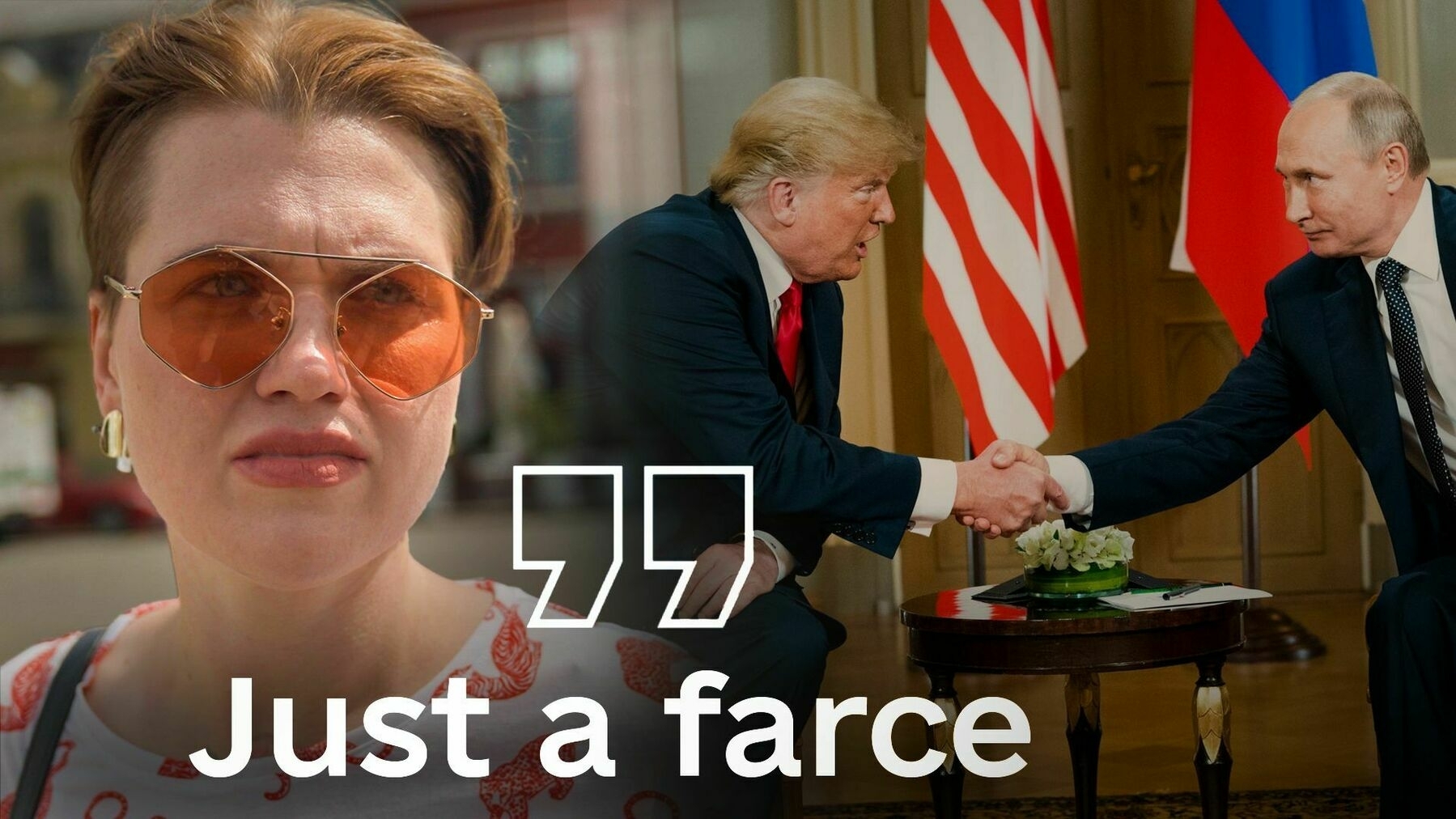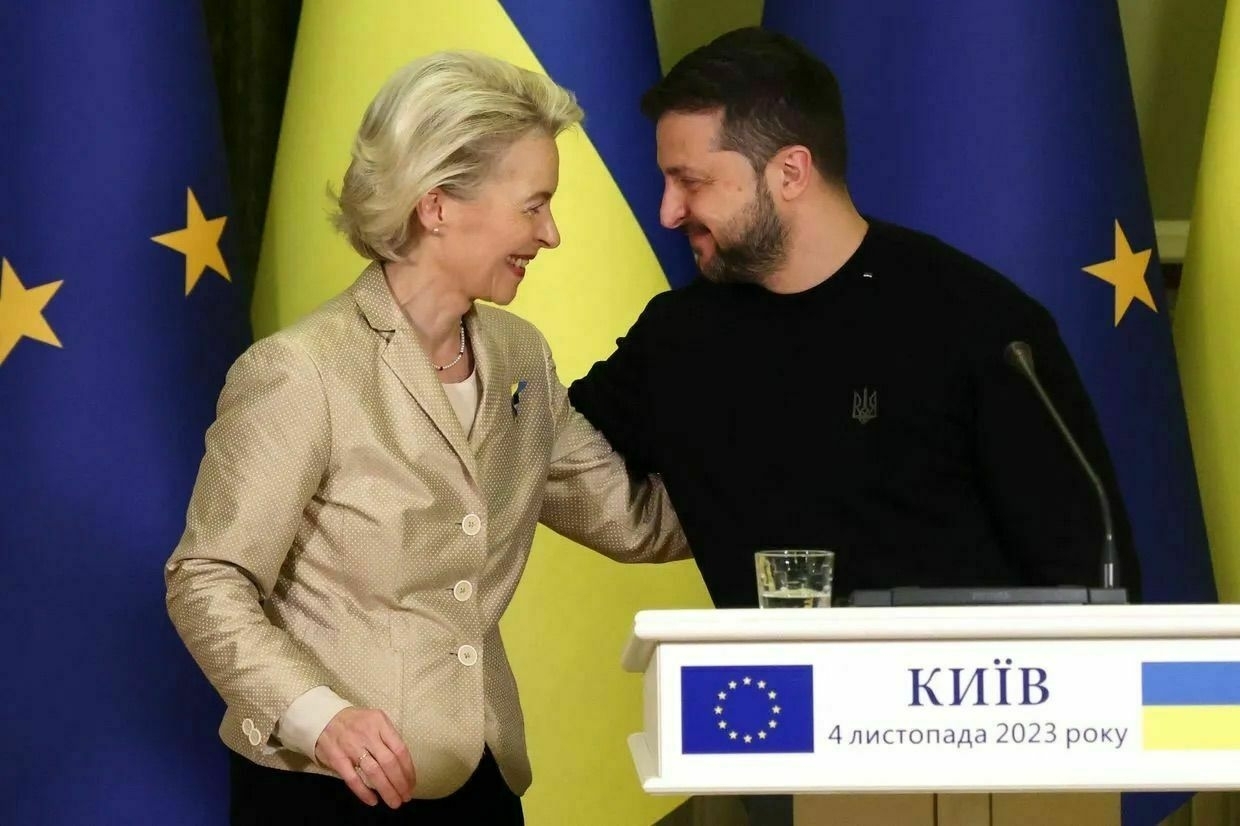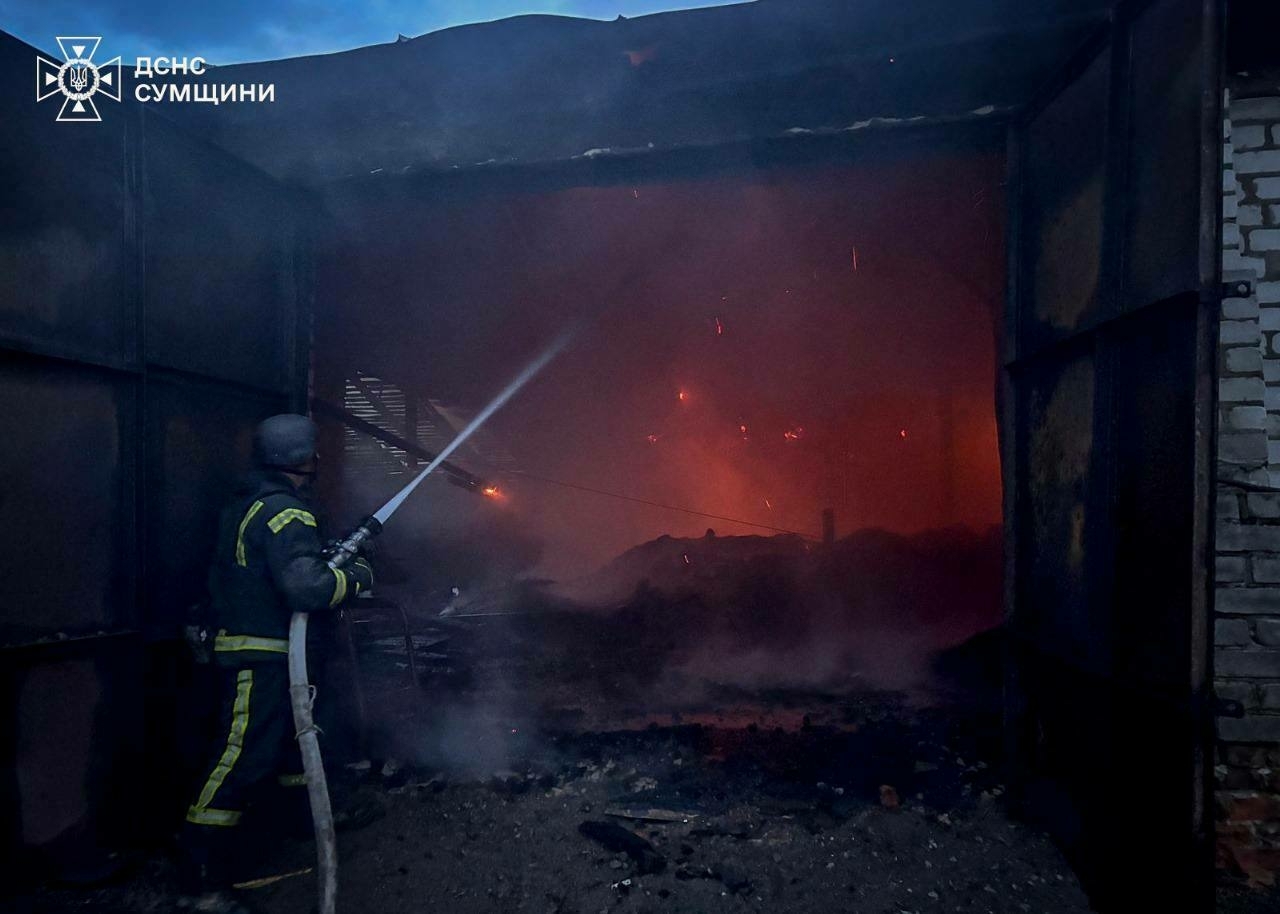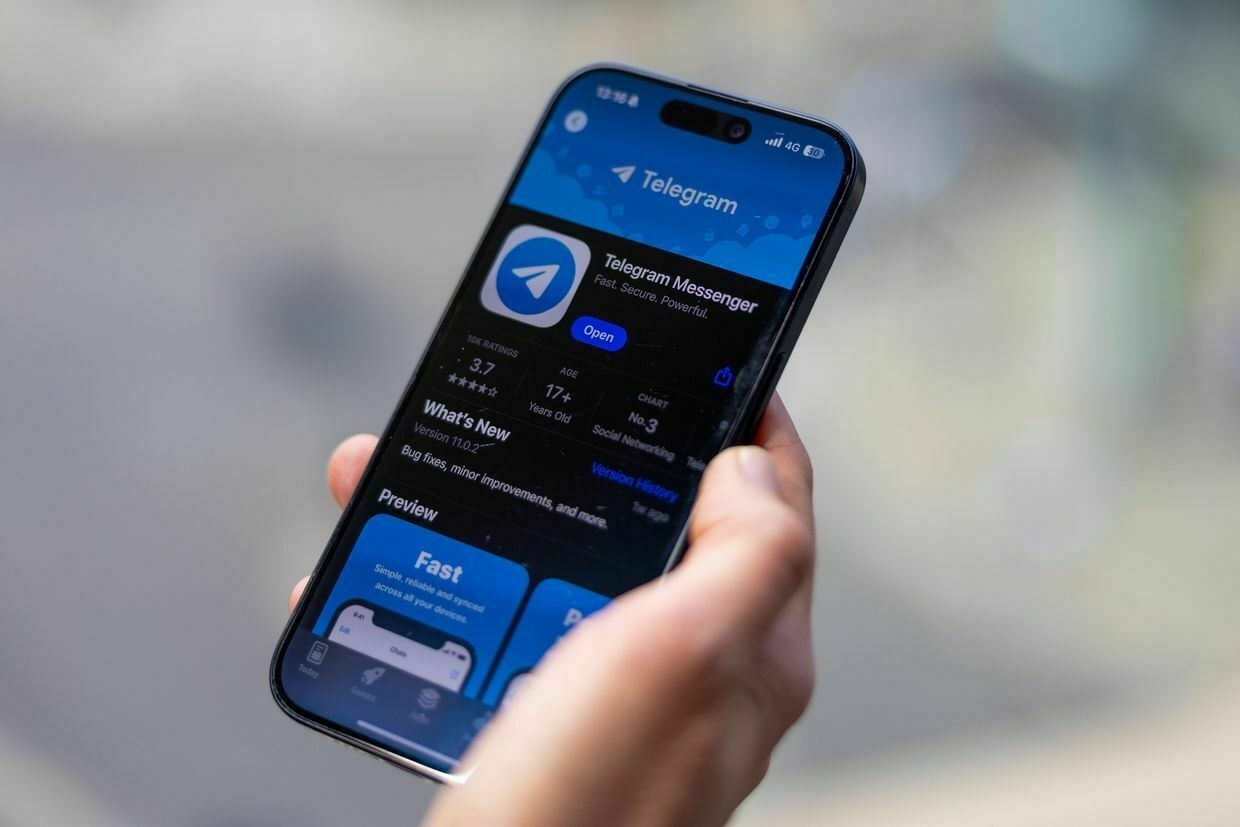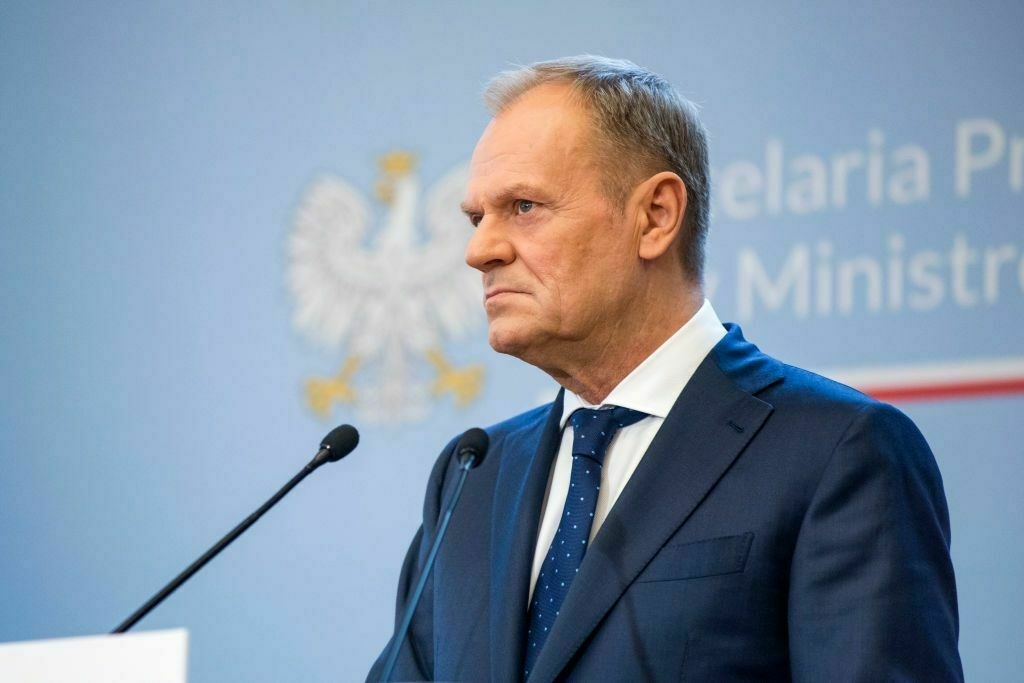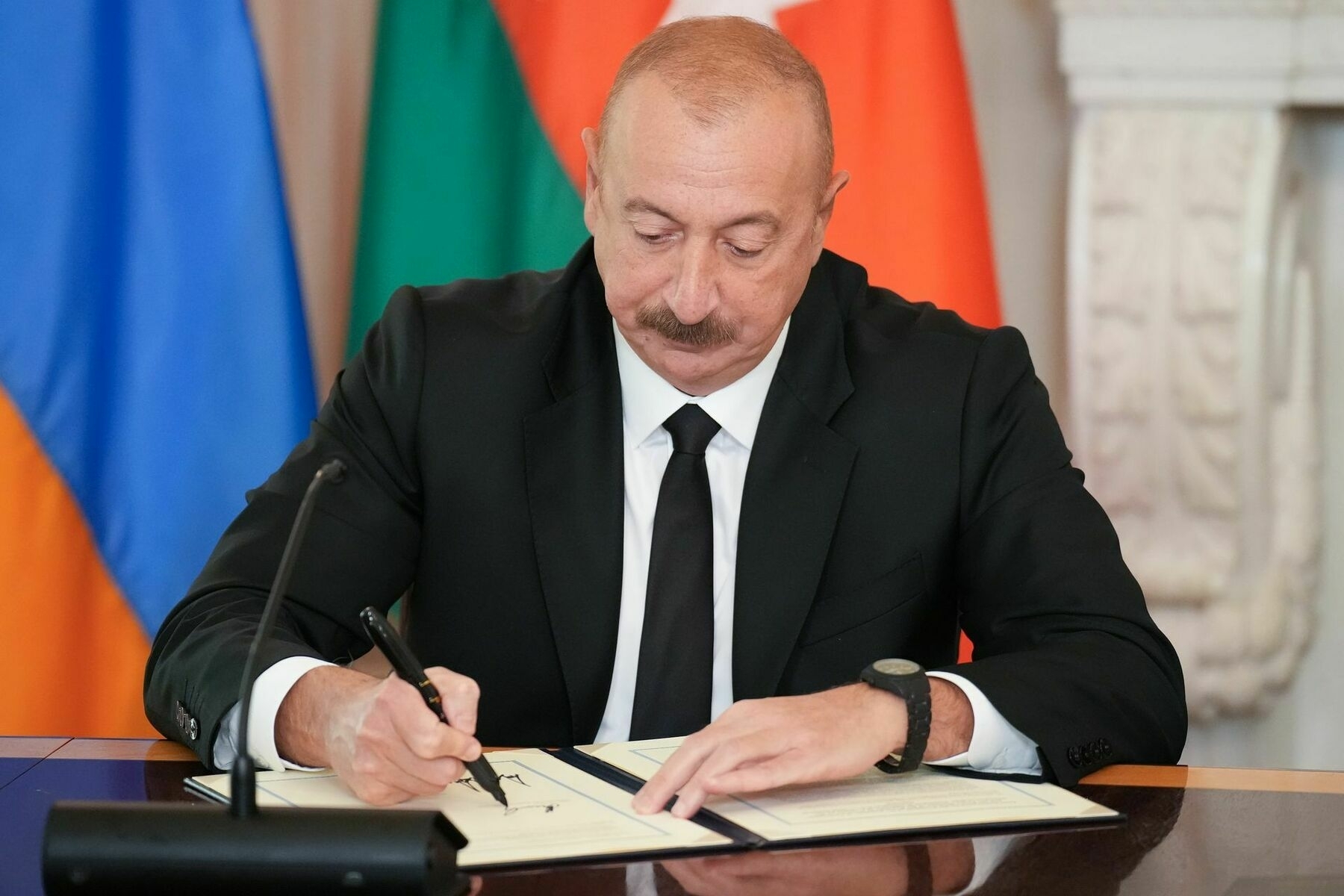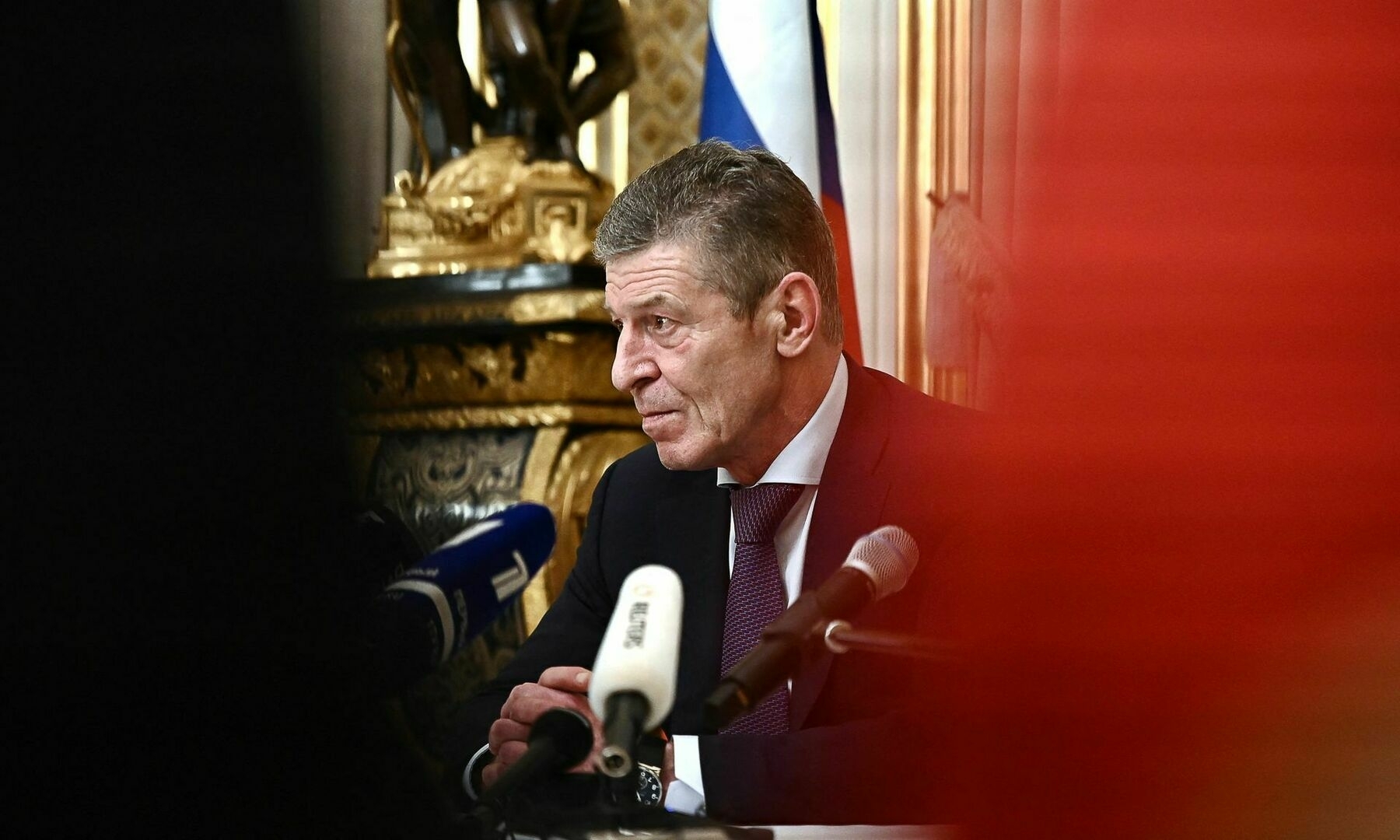-
Trump says Zelensky won't attend Alaska summit with Putin, but Ukraine-Russia talks should follow
-
“I’m grateful that I’ve captured a moment when city was in its prime” — Director Jonathan Ben-Shaul on Kharkiv before and during Russia’s war and movement as method of reflection in art
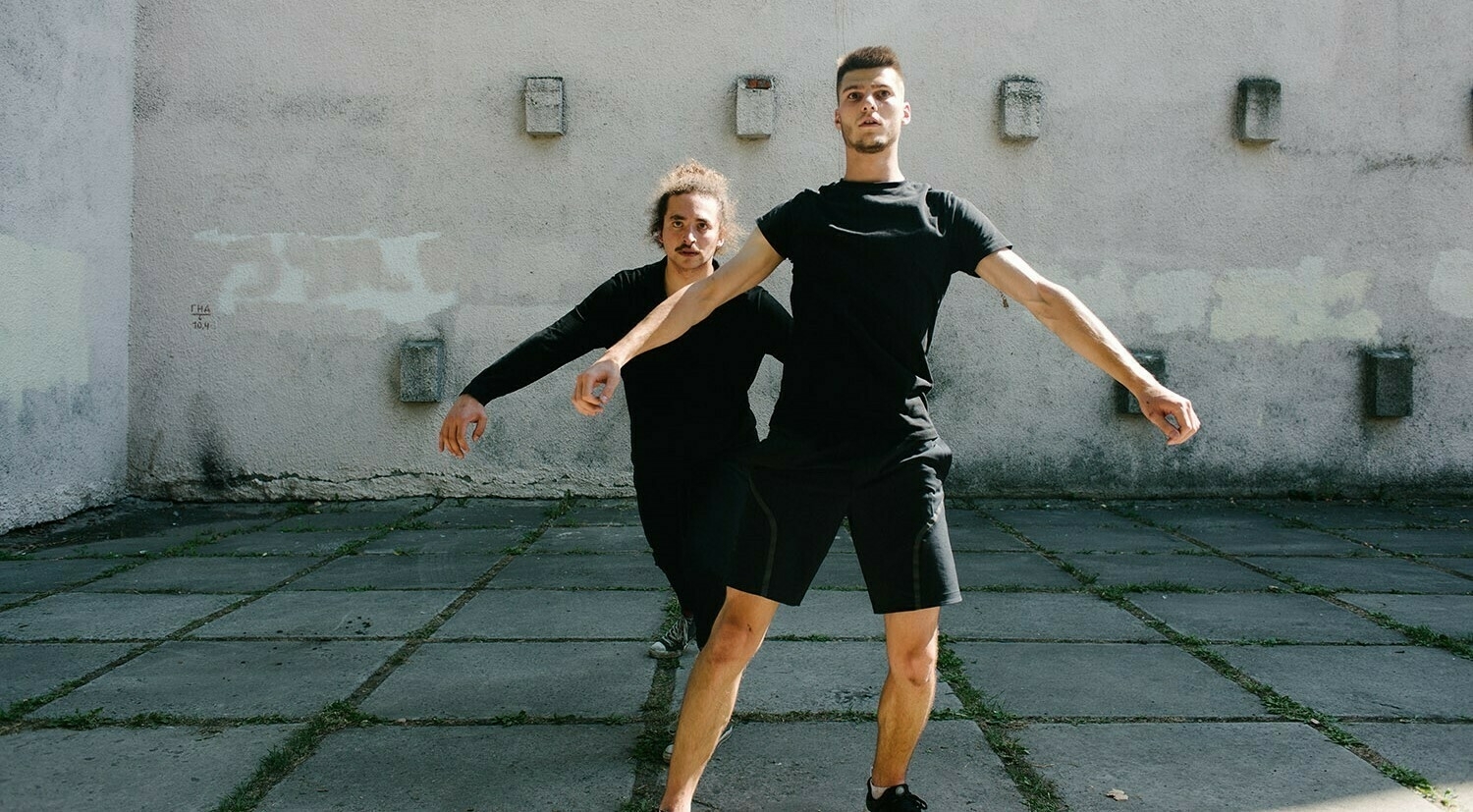
In 2021, Jonathan Ben-Shaul, director and choreographer from London, made a documentary-dance film called What Shall We Do With These Buildings? in Kharkiv. The film investigates the legacy of Soviet architecture in the city through movement. Less than a month after premiere, Russia launched full-scale invasion, and their incessant air attacks changed the landscape of the city. Ben-Shaul, then, launched a theater lab in Ukraine, teaching students to explore their surroundings with motion.
Gwara Media interviewed the artist about his experience, artistic method, and impressions of Kharkiv before and after the big war.
You shot What Shall We Do With These Buildings? in 2021, shortly before the invasion. What exactly brought you to Kharkiv then?
It was four years ago, in September 2021. The film was the result of my participation in the Kharkiv Slovo residence in partnership with the Literary Museum and the Kharkiv School of Architecture. I was interested in the impact of Soviet modernism on the city. During those times, there were a lot of talks about ukrainization (increasing usage and promoting Ukrainian language and culture — ed.), preserving heritage, and creating new architecture for new generations. We tried to capture the culture being formed at that moment and talk to people who were discovering the architectural heritage and rethinking their Ukrainian identity.
No one could have imagined that everything would change six months after the filming was completed. The whole thing stopped and was completely shaken to its core by the full-scale Russian invasion.
Has your perception of the footage you shot changed since the beginning of the war? Russian attacks may have damaged some buildings on it.
Many people asked, “What about the buildings? Are they okay?” And I have to be honest with you — I don't care. I am most concerned about people and cultural activities. Yes, of course, I want symbolic architectural objects like the Derzhprom or the Kharkiv State Academic Opera and Ballet Theatre to be preserved, to get a new identity after the war, and to become cultural centers again. But people are more important than buildings.
Were there any buildings or locations that made a special impression?
Oh, there are so many. Of the ones in the movie, it’s the last one, where we interviewed Oleh Drozdov. We called it the Students' Palace School of Nutrition.
It is an incredibly playful and exciting building. I think it was built at the end of the 1970s or early 1980s, a time when many architects already knew that the Soviet Union was falling apart and felt that freedom was on the horizon, but they still had the funding to realize their hopes for a new future. This building embodies that very well — filled with joy and life. These are the things that inspire me the most.
Apart from the movie's buildings, I love Central Park, Sarzhyn Yar (another park in central Kharkiv), and the cable car connecting them. I love all these restaurants, pubs, and the river. There were many places in Kharkiv that I really liked.
The film premiered on January 30, 2022, less than a month before the full-scale invasion. How did you tell your audience about the film and Kharkiv?
The first show took place at the Parade-Fest (a theater and urban festival in Kharkiv), where we presented the film to the local audience — the people who starred in the film and the staff of the Literary Museum and the School of Architecture. We showed the film in a tent right next to the Derzhprom. I remember that we made the final cut, I slept for 20 minutes, — and ran to the premiere with a flash drive to show the film.
After that, we held several more shows. The first festival premiere was in Norway. Before that, we did a few preview screenings in London, one before the full-scale invasion started and one right after. It was a very emotionally difficult period for all of us. I was worried about the people who were in the movie and my friends in Kharkiv and all over Ukraine. I feel grateful that I captured the moment when Kharkiv was in its prime — in September 2021 — when civil society was beginning to actively lead the city toward a great cultural revival.
Now, films like yours are becoming archival.
Yes, this film is about how memory is implemented in the urban landscape. Many buildings were created during the colonial period (under Soviet occupation or imperial Russia). The footage raised questions: What should we do with this heritage now? Do we preserve it? Destroy it? Rethink it?
Like many people in the UK, especially before the Russian full-scale invasion, I had a lot of wrong ideas about Ukraine that were the result of Russian colonization. So I, like many other Ukrainians, went through a process of decolonization. That's why this film became a so-called time capsule. It captured the moment when Kharkiv was independent, alive, and looking for itself. Before the war, few people in the UK knew about this city. So it was important for me to show that there was a culture there, parties, evenings, and thoughts about the future. This is much more important than constant talk about sirens.
Movement is an interesting tool for expressing ideas, why did you choose it?
Together with Mykola Naboka, my close friend and colleague from Kharkiv, who participated in filming, I studied at the Jacques Lecoq School in Paris. There, we learned a method based on observation and mimicry that became the pedagogical basis of the film. We interviewed architects and ordinary people who use buildings, and we felt this was not enough. We wanted to convey a bodily sense of space. What do you feel when you pass by Derzhprom every day? What does studying at KhAI (National Aerospace University “Kharkiv Aviation Institute”) feel like? What does it feel like to live in these buildings? These are questions that we, as users of space, almost never ask ourselves, but they have an impact.
I think spaces have a profound influence on how we exist. The only way to capture that is to try to “reverse” the architectural process through dance. What movements do these buildings suggest? How can we explore this? The only way is through movement. This was our starting point.
Since then, I have made four other films with my company, Moving House Films. We did similar research with other, very different, types of buildings. Also, the course I taught here in Lviv, in collaboration with the Physical Theater Laboratory and the artistic association Khvylia, was very focused on this type of research.
What movies inspire you?
Various documentaries. I remember seeing a lot of incredible films at festivals. One was also made by a Ukrainian documentary filmmaker. It's called Liturgy of Anti-Tank Obstacles by Dmytro Sukholytkyy-Sobchuk. It's a brilliant film about how sculptors started making anti-tank hedgehogs after the Russian full-scale invasion began. These things — experimental architectural projects — inspire me.
Tell us about the Physical Theater Laboratory. Is this your first teaching experience?
Since I left Ukraine four years ago, I have wanted to come back as soon as possible, but the war has postponed this. Mykola moved to Lviv and opened the Physical Theater Laboratory, which is based on Jacques Lecoq’s methodology. For the last two years, I have been coming there to teach the younger generation of actors, designers, and architects.
This year, in the lab, we were working on space analysis. We had an incredible group of students from all over Ukraine, including from the frontline territories. They came to Lviv to research and study the city.
We worked with them for two weeks, teaching methodology basics: how to feel space, transform this experience into movement, and then structures and forms. We also gave each of them an assignment — an envelope with a location in Lviv that they had to explore. These were spaces from different historical periods: Dominican Church, Krakivskyi market, Sknylivskyi park, and other places. The students worked in groups, explored the spaces, and then created a final project — a living archive of their experiences in these places through movement and construction.
Now, more than ever, it is important that young people find a new culture, a new identity, and discover European approaches to theater. In Ukraine, the psychological approach to theater is quite strong. This exchange feels very necessary — to give young people the tools to create their own art, to rethink ideas and spaces in a new way.
How do you find working with Ukrainian actors? Did you learn anything new?
The students were incredible. This year, we received support from the British Council, which allowed us to make the course free and invite more people. We also had a public program — performances by invited artists from the UK who joined online and were able to talk to the young people here and give them an idea of what opportunities exist in the world. It was an extremely touching exchange of experiences and connections. Every time we do a workshop like this, it's always exceptional to see what they can create; to be surprised, amazed, and blown away by what they do as individuals.
Besides supporting Ukrainian theater, how else do you help here?
Bringing this cultural and pedagogical experience here is very important to us.
As for the rest, What Shall We Do With These Buildings? continues to travel the world, participating in international film festivals. We are spreading the message about what Kharkiv was like before the Russian aggression. We have already raised about £20,000 ($26,562) for humanitarian aid. We have dedicated all the profits from this movie to help Kharkiv.
When you're abroad, you can read a lot about Ukraine and what life is like here, but you really don't know anything until you come here and experience it firsthand. I didn't come alone, but with colleagues from Spain, Switzerland, France, and the UK — we all talk about Ukraine as it is now and the creative energy that exists here.
You have not been to Kharkiv since the beginning of the full-scale invasion. Would you like to visit the city again, perhaps with a new project?
Of course, I want to return to Kharkiv. I want to walk around my favorite places, see my friends, and maybe shoot a sequel.
There is a lot of talk in the architectural world about reconstruction and how this process should take place. I think this would be a very interesting focus for a new movie in the future. We organized a screening of What Shall We Do With These Buildings? at the Royal Institute of British Architects, where Oleh Drozdov and Norman Foster, who is actually the chief architect for the reconstruction of Kharkiv, met each other. Their conversation raised many important questions about who should lead the rebuilding of Kharkiv. Should it be Norman Foster and his team? Or should it be people themselves? And how should this reconstruction take place? How can Ukrainian identity be incorporated into the reconstruction of these buildings? And how can we preserve part of the heritage? These are the things we would like to explore in the future.
Thank you for your interest in Ukraine's cultural life — although it slowed down significantly with Russia's war, it is still moving forward. Please, consider also supporting our Kharkiv-based newsroom by buying our journalists a coffee or subscribing to our Patreon.
Read more
- “I make performances that ask — okay, what will you do now?” Director Alin Uberti on organizing workshop in Kharkiv, crafting alternative theater in Romania, and Russian promises to Bucharest
- “I cried when I saw Kharkiv laugh again.” Nina Khyzhna on how Nafta Theater embraces changes that come with war
The post “I’m grateful that I’ve captured a moment when city was in its prime” — Director Jonathan Ben-Shaul on Kharkiv before and during Russia’s war and movement as method of reflection in art appeared first on Gwara Media.
-
Trump to hold talks with Zelensky, EU leaders 2 days before meeting with Putin
-
NEW records! Ukraine is CONTINUOUSLY attacking Russian military facilities #shorts
-
Rutte concedes future peace deal may acknowledge Russian control of occupied Ukrainian land
-
Ukrainians react to Trump's plan for talks with Putin
-
Azerbaijan pledges $2 million in humanitarian aid to Ukraine amid Russian attacks on energy infrastructure
Azerbaijan has pledged $2 million in humanitarian aid to Ukraine after recent Russian strikes targeted its energy infrastructure. This announcement comes as President Ilham Aliyev issued a decree on Monday, August 11.
The decree emphasizes humanitarian principles and is based on bilateral and multilateral agreements between Baku and Kyiv. The funds, sourced from Azerbaijan's reserve fund, are dedicated to supporting Ukraine's energy sector, which has been heavily impacted by the Russian attacks. These financial resources will be allocated to Ukraine's Ministry of Energy to facilitate the purchase and delivery of electrical equipment.
Baku also highlighted its history of sending humanitarian supplies to the Ukrainian people amid ongoing Russian aggression. Notably, on August 10, Ukrainian President Volodymyr Zelensky had a conversation with Aliyev. Both leaders condemned Russia’s deliberate strike on an oil depot owned by the Azerbaijani company SOCAR.
Last week, Russian forces also attacked a gas transmission infrastructure near Ukraine’s border with Romania at Orlivka in the Odesa region. This terminal facilitated gas flow from the U.S. and Azerbaijan into Ukraine.
Additionally, Azerbaijani gas was supplied to Europe through this station. Meanwhile, media reports indicate that Azerbaijan has warned Russia of potentially lifting its ban on arms supplies to Ukraine if Moscow continues to target Azerbaijani company facilities in Ukraine.
-
EU to channel $1.7 billion from frozen Russian assets to repay Ukraine's loans
-
Undercounted and erased: The world has underestimated how many civilians Russia has killed in Ukraine
Leaving a permanent stain on the reputation of the New York Times, Pulitzer laureate Walter Duranty wrote in 1933: "You can't make an omelette without breaking eggs." The Soviet experiment was the omelette. The eggs were millions of Ukrainians deliberately starved by Moscow for wanting freedom.
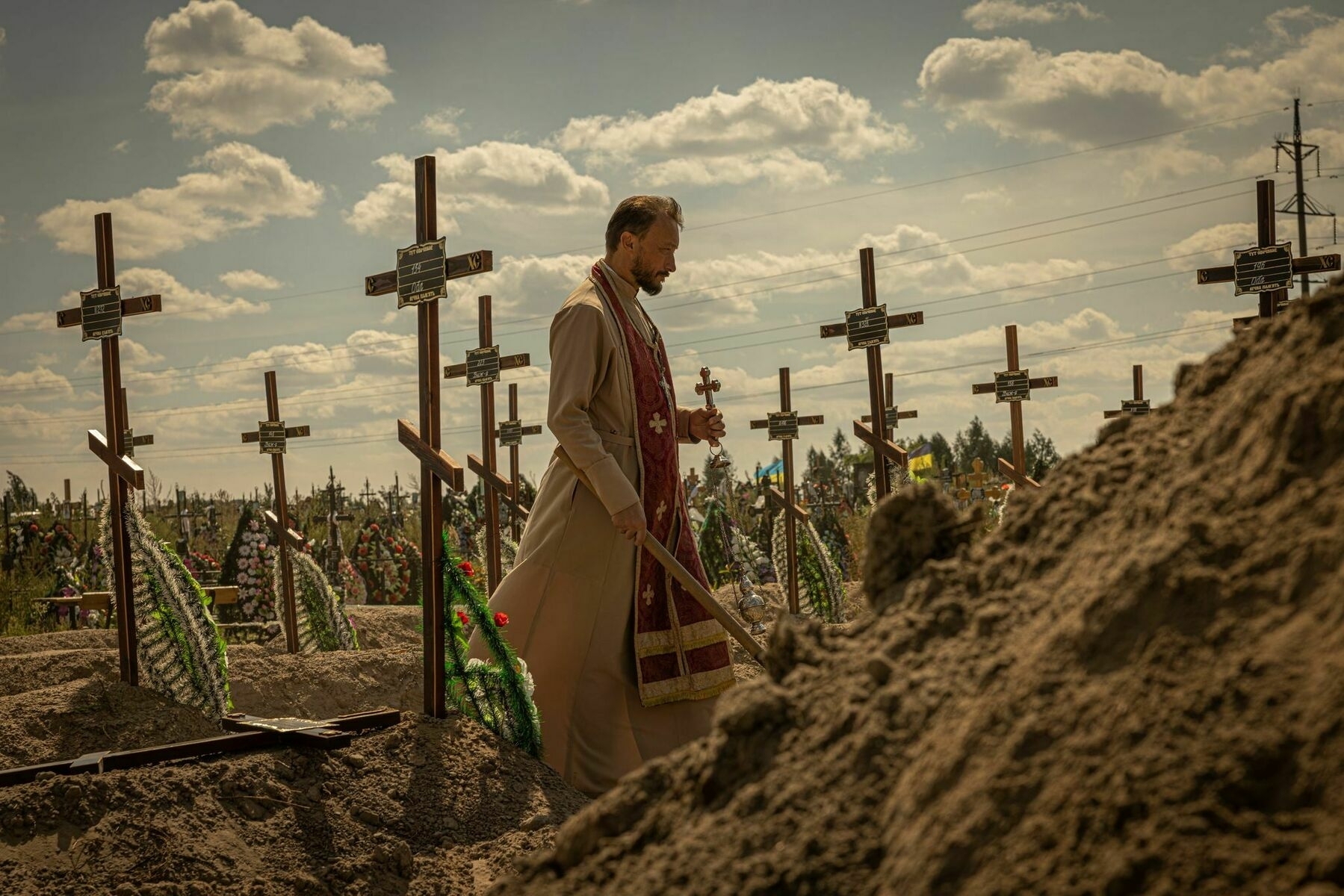
-
Ukrainian drone strikes hit Nizhny Novgorod industrial zones
Two industrial zones in Russia's Nizhny Novgorod region, including one in the Arzamas district, came under attack from Ukrainian drones late Sunday night, August 11. According to a Telegram post from regional governor Gleb Nikitin, one employee was killed on the spot, and two others were hospitalized.
The governor did not specify which factories were targeted by Ukrainian forces. However, Ukrainian media and Telegram channels speculate that one of the targets was likely the Plandin Arzamas Instrument Engineering Plant, known for producing equipment for the aviation and aerospace sectors as well as for civilian use, according to Ukrainian outlet Channel 24.
Meanwhile, the pro-Kremlin Telegram channel Mash reported that witnesses heard "three pops and one powerful explosion" around 3:55 a.m. over Arzamas. The report mentions sightings of at least five drones flying extremely low near the northern outskirts of the city, close to the village of Zhiguli.
Later, around 11:00 a.m. Moscow time, Reuters quoted an unnamed officer from Ukraine's SBU intelligence agency stating that "at least four drones struck the plant in Arzamas, which manufactures control systems and other components for Russia's X-32 and X-101 missiles."
The second potential target for the Ukrainian drones, as suggested by the Telegram channel Astra, could have been an "industrial zone in Dzerzhinsk, where military enterprises are located".
On the evening of August 10, Dmitry Milyaev, governor of the Tula region, announced an "aerial attack on one of Tula's civilian enterprises," resulting in two fatalities. The governor did not disclose specific targets, stating only that "injured individuals have been hospitalized and are receiving necessary medical care."
Russia's Ministry of Defense reported on the morning of August 11 that over the previous night, 32 Ukrainian fixed-wing drones had been intercepted and destroyed over Russia and the annexed territory of Crimea. This included seven drones over Belgorod, five each over Bryansk and Kaluga regions, four over annexed Crimea, two each over Oryol, Kursk, Voronezh, Ryazan, and Moscow regions, and one drone over Tula.
In a subsequent statement the same morning, the Russian defense ministry confirmed an attack on the Nizhny Novgorod region, declaring that two drones were shot down there. The same post mentioned the destruction of four additional drones over Crimea and one more over Belgorod.
-
Drones in action: strikes on Kherson region and a defence plant in Russia
-
1,400 Russian drones battered Ukraine last week, Zelensky says ahead of Trump-Putin summit
-
Russia reportedly tests blocking Telegram, WhatsApp calls amid internet clampdown
-
Russia suspected of sabotaging Azerbaijani oil shipment to Romania
Romanian intelligence suspects Moscow in an act of sabotage against Azerbaijani oil, aimed at undermining Romania's energy supply.
According to a report by G4Media, Russia intentionally contaminated a large shipment of Azerbaijani oil headed to Europe, in what is perceived as an attempt to destabilize the energy networks of NATO ally countries. The attack leveraged a relatively simple method—chlorine contamination.
Reports indicate that oil containing hazardous levels of organic chlorine was delivered through the "Baku–Tbilisi–Ceyhan" pipeline in July. This contaminant could damage refinery equipment, impairing their operations. A tanker carrying 184,000 tons of this contaminated crude was denied entry at the Romanian port of Constanța, leading to a temporary fuel shortage at OMV's refinery.
Romanian sources suggest this contamination was part of a hybrid operation, where chlorine was deliberately introduced into the pipeline. Suspicions have mounted amid a recent flurry of Russian propaganda on TikTok, alleged election meddling attempts in Romania, and Russian drone strikes on Azerbaijani infrastructure in the Odessa region.
Relations between Russia and Azerbaijan have been deteriorating amidst incidents such as the arrest of Azerbaijani nationals in Russia and a plane crash near Aktau. This has led to mutual accusations and a decline in diplomatic relations.
By compromising Europe's energy security, Moscow risks creating new adversaries. Both Azerbaijan and Romania, previously restrained, may adopt firmer stances against the Kremlin. Such actions reinforce calls within the EU and NATO for Russia's complete isolation from energy markets and increased support for Ukraine.
Experts assert that Russia's attempts to influence geopolitics via sabotage reflect a lack of strategic forethought, inviting new diplomatic spats and furthering its reputation as a global rule-breaker.
-
US pledged to consult Europe ahead of Trump-Putin summit, Polish prime minister says
-
Another Russian general from Shoigu's team jailed for bribery
-
Aliyev approves $2 million energy aid to Kyiv following Russian strikes on Azeri-linked sites in Ukraine
-
Sanctions Against the Russian Science: Current Results So Far
One of the famous narratives of Russian propaganda: sanctions are not working and they are not efficient. Indeed, despite 25 000+ different sanctions (mostly concentrated on Russian economy) Russian Federation is not only still alive but is able to continue the biggest war in the world since WWII. At the same time, Russia starts any negotiations with demands to lift the sanction pressure. This is a little bit suspicious: why is it so important to ease “non-working and inefficient” sanctions?
One of the explanations for this phenomenon in the economic sphere is simple: fabrication or concealing of statistics by Russian authorities, such as Rosstat (Russian statistical agency). It is a form of propaganda used to create the image of “strong and invincible Russia” (Plastun et al., 2024).
However, there is one area of Russian activity where we have unbiased data: international science. The results of sanctions against Russian science can be evaluated more or less precisely. We have done this in Kozmenko et al (2025) and summarize our research in this article.
International sanctions against Russian academia involve a range of measures, including bans on the supply of equipment and technology, termination of cooperation in projects and grants, suspension or reduction of funding, restrictions on academic mobility, limited access to international databases, and constraints on the ability to publish research findings, among others (Plastun, 2025).
In June 2022, the US announced the closure of federally funded research partnerships with Russia (Ambrose, 2022). The G7 science ministers pledged to restrict government-supported collaborations involving Russian entities. The European Commission froze all agreements with Russian partners and suspended payments under programs like Horizon 2020 and Horizon Europe, where Russia previously participated in 138 projects and received €14 million. Germany immediately halted all joint educational and research activities, while the UK withdrew funding from projects with ties to Russian institutions and banned new collaborations. The Netherlands, Denmark, Latvia, Lithuania, and Finland all froze academic ties, suspended exchanges, and prohibited new partnerships with Russia and Belarus (Upton, 2022a, 2022b). Similarly, Norway cancelled cooperative calls for research proposals, Poland ceased collaboration across academic sectors, and Canada urged scientists to avoid links with Russian industry.
In response to Russia’s continued military aggression, several international scientific collaborations have been suspended at the project level. CERN officially terminated its cooperation agreement with the Russian Federation starting from November 2024. The European Space Agency (ESA) also ended its joint work with Roscosmos on ExoMars and the lunar projects Luna-25, Luna26, and Luna-27. The EU-backed CREMLINplus initiative terminated its partnership with Russian participants. Massachusetts Institute of Technology suspended the project on Moscow’s western outskirts development. Closure of bilateral projects with Russia is also detected in Australia and Germany (German Research Foundation Deutsche Forschungsgemeinschaft and the German-built eROSITA telescope).
The corporate sector has also responded, with multinational corporations adjusting their social responsibility strategies and withdrawing R&D operations from Russia, as highlighted by Kharchenko et al. (2024). Major global tech firms imposed corporate sanctions in science. Mostly in 2022, research centers and facilities were closed all over Russia by Dell Technologies (RFE/RL, 2022), Nvidia and Siemens, IBM, and SAP. Intel sold its facilities in Russia in 2023. Nokia closed its laboratories at Skolkovo and St. Petersburg and officially exited the Russian market.
Supply chain level disruptions critically affected equipment, reagents, and materials procurement procedures for Russian institutions. Before the full-scale war at the beginning of 2022, up to 80% of equipment tenders were won by foreign companies, and dependence of the “life sciences” on Western reagents was about 90%.
A substantial share of research equipment used in Russia is sourced from European and American laboratories. According to COMTRADE data, in 2020, approximately 13.8% of Russia’s imported scientific equipment originated from Germany, while 6.1% was supplied by the United States. Following the invasion, the European Union imposed restrictions on the export of various categories of technical equipment to Russia. In response, major companies such as Zeiss, Nikon, and Thermo Fisher Scientific either halted or suspended their supplies to Russia.
The easiest way to assess the impact of sanctions on Russian academic publication activity is to explore bibliographic databases. The largest and most famous databases to date are Scopus and Web of Science (WoS). Today, Scopus is bigger than WoS. It has 1.8 billion cited references dating back to 1970, 84 million records, 17.6 million author profiles, more than 25,000 active titles, and 7,000 publishers (Elsevier, 2023). Scopus journals’ coverage is higher than in WoS (42,000 vs. 34,200) and broader (including life sciences, humanities, etc.), which is vital for comparison. The content of these databases overlaps significantly.
The period of analysis is 2013–2024 (2013 was the last year before the occupation of Crimea and the creation of the so-called Donetsk People’s Republic (DPR) and the Luhansk People’s Republic (LPR) controlled by Russia. In the first period of Russia’s aggression against Ukraine (2014-2022) there were no official or systematic efforts to sanction Russian science, and after the full-scale invasion in 2022-2024, sanctions were introduced. The data was collected on May 1, 2025.
Since the start of the full-scale war the publication activity of scientists affiliated with Russia significantly declined compared to 2021-2022. Figure 1 provides the dynamics of key metrics (number of publications affiliated with the Russian Federation, number of citations, and number of views) for 2013–2024. Note that during the first stage of the war, in 2014-2021, the number of publications, their citations, and views steadily increased. They peaked in 2021, when there were 137.5 thousand publications; the most citations and views were observed in 2020 (1,102,231 citations and 3,619,050 views).
The sad fact is that this growth of Russian publication activity was supported by Ukrainian academicians as well. Even nowadays (summer, 2025) we have revealed 80+ Ukrainian academicians still mentioned as editorial board members of Russian journals.
Figure 1. Key indicators of publication activity affiliated with the Russian Federation for 2013–2024
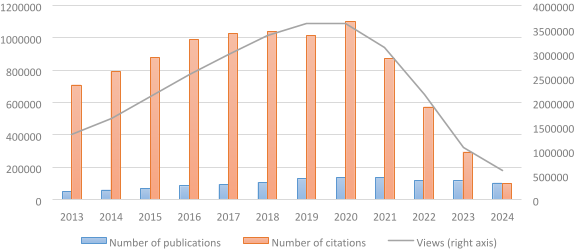
Source: Built-in Scopus instruments and Scival. Note: number of citations shows how many times papers published in a given year were cited (i.e. how many citations they generated)
The number of publications affiliated with the Russian Federation in 2022 was 14% lower than in 2021, and the number of publications in 2024 was 26% lower than in 2021. For citations, the decline was much larger: in 2022, there were 34% less citations than in 2021, and in 2024 their number was 89% lower than in 2021. The number of article views in 2024 fell by 81% compared to 2021.
Note that at least several months pass between the date of submission of the manuscript and the date of its publication, hence, some papers published after sanctions were introduced were submitted for publication well before that. The citation count in SciVal reflects the total number of citations of papers published in a given year, regardless of when those citations occurred.
Based on the average growth rate during 2013–2021 (13.3%), the number of publications in 2022 should have been 155,814 instead of the actual 118,054, and in 2024 185,784 instead of actual 102,434 (Figure 2). This means up to 45% (!) of publications were not published in 2024 because of sanctions.
Figure 2. Real (orange) and projected (grey) number of publications affiliated with the Russian Federation for 2013–2024

Source: Built-in Scopus instruments, Scival, and authors’ calculations.
One of the most prominent examples (and the most expected because of rogue-state status) is the proportion of academic conference papers with authors affiliated with Russian universities or research institutions, which fell by 57% in 2022, with a further drop in 2024 (see Figure 3). For example, the Journal of Physics Conference Series (by the United Kingdom) accepted 5,912 papers from Russian scientists in 2021, 1023 in 2022 (Matthews, 2023), and only 213 in 2024 (83% less). The same trend is observed for the Institute of Physics (IoP) Conference Series Earth and Environmental Science (also by the United Kingdom): in 2021, there were 5712 papers, and in 2024, only 68.
This decline occurred via different channels: either directly (for example, the Institute of Physics explicitly announced that they would not commission papers from Russian or Belarusian institutions) or indirectly (e.g. Western institutions cannot get payment fees from Russia or Belarus, Russian scholars cannot get visas or are afraid to go).
Figure 3. Conference papers outputs with Russia-affiliated authors in 2000–2024
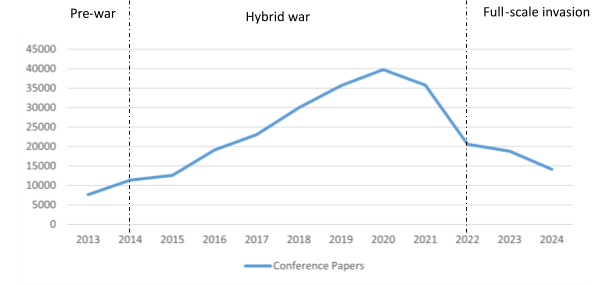
Source: Built-in Scopus instruments
Based on the subject area analysis, the biggest losses (more than 40% decrease in number of publications) in academic activity in 2022 were generated in energy, earth and planetary sciences, and environmental science. Physics and astronomy have lost 19.59% in Scholarly Output (i.e. the number of publications indexed in Scopus) after the invasion, economics, econometrics, and finance – 17.29%. In 2024, almost all subject areas had a decline in publication activity compared to 2021, most notably environmental science (–50.59%), earth and planetary sciences (–47.13%), decision sciences (–44.84%). On the other hand, areas such as dentistry and agricultural and biological sciences have seen a growth in their Scholarly Output (+21.48% and +2.55%, respectively).
A similar analysis of the case of institutions showed that in the top 10 Russian academic institutions, seven have lost from 20% to 40% of scholarly output and from one-sixth to one-fifth of authors (Table 1). An interesting observation is that in the top 10 institutions in the government sector (i.e. those affiliated with the Russian Academy of Sciences or some ministries), 40% demonstrated a decline in scholarly output, but in the academic sector, 80% have seen their publications decline.
Table 1. Institutions with the biggest losses in academic activity between 2021 and 2024
Institution Scholarly Output (% change) Number of authors who published (% change) St. Petersburg National Research University of Information Technologies, Mechanics and Optics (ITMO) –41 –26.5 Novosibirsk State University –34.5 –22.4 Moscow Engineering Physics Institute –30.8 –25.6 Tomsk State University –24.4 –13.8 Moscow Institute of Physics and Technology (on OFAC and SDN sanctions list) –20.8 –14.3 Ural Federal University –20.5 –14.8 Peter the Great St. Petersburg Polytechnic University –19 –20.5 Kazan Volga Region Federal University –17.7 –14.5 St. Petersburg State University –13.2 –7 Lomonosov Moscow State University –6.6 –4.2 Source: Scival and authors’ calculations. Note that these institutions are mostly not sanctioned individually, so this is the effect of general sanctions
A downward trend is also observed in different forms of collaboration with Russian scientists (Figure 4). In 2022, both international and national collaborations, as well as individual authorship, fell by 12%. Institutional collaboration decreased by 20%. In 2024 the decline continues, in particular, the international collaboration is by 34% lower than in 2021.
Figure 4. Changes in collaboration metrics by the Russian Federation scientists for 2013–2024
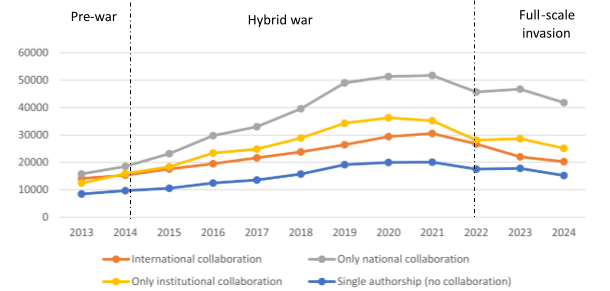
Source: Built-in Scopus instruments, Scival, and authors’ calculations.
From the point of view of collaborating countries/regions, the most important ones for Russian academia nowadays are Europe, Asia Pacific, and North America. In the geographical dimension, Russian academia shows patterns similar to its economic and political spheres — a shift from Western countries to China, India, and Turkey.
In the top 20 countries by co-authored publications after the full-scale invasion, 19 (95%) decreased activity by 2024, and only India slightly increased it. The most significant drop in the top 20 is observed in Ukraine (70% – see Figure 5), Poland (54%), and Germany (47%).
Figure 5. Papers where Ukrainians and Russians are co-authors by year of publication
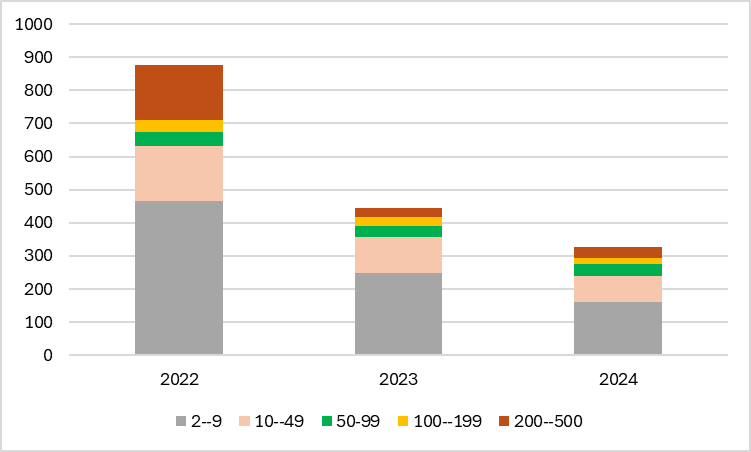
Source: Built-in Scopus instruments, Scival, authors’ calculations. Note that some papers have a very large number of co-authors (usually these are produced under some large-scale international research projects), so Ukrainian scientists have no leverage over who else participates or may not even know all the project participants
This decline may be attributed not only to international sanctions but also to a number of additional factors. They include reduced research funding, brain drain due to the emigration of highly qualified scientists from Russia, limited access to international collaboration and data infrastructure, reputational isolation within the global academic community, and increasing political control over academic institutions and research agendas within Russia.
Findings reveal that sanctions against Russian science are quite efficient and provide evidence in favor of further efforts in this direction. At the onset of Russia’s full-scale invasion, Dmytro Chumachenko, in an Open Letter from Scientists of Ukraine, provided a comprehensive list of such efforts. These included cutting Russian access to research databases and publishers, banning their participation in international grants and exchange programs, boycotting scientific events in Russia, and excluding Russian scholars from journal editorial roles.
Despite the efficiency, the sanctions imposed on Russian science cannot be described as global, systematic, or consistent. In most cases, they represent only isolated elements of what could be a broader and more effective sanctions strategy. Additional measures could include initiating a new wave of academic debate on sanctions against Russian science, developing coordinated sanctions policies by the EU, US, and other partners, and reviewing collaborations with Russian academic institutions and journals to prevent support for the war or violations of academic integrity in scientific papers. Moreover, excluding from indexing any papers that mislabel Ukrainian territories as part of Russia, banning the responsible authors and journals. Finally, one should exclude Russian academic institutions involved in propaganda or war support from the international academic organizations.
These measures could increase the pressure on the Russian Federation in general and might speed up the end of the war.
References
- Kozmenko, S., Vorontsova, A., Ostapenko, L., Plastun A., & Plastun, V. (2025). Sanctions on Russian academia: Are they efficient?. Journal of International Studies, 18(2), 255-269. doi:10.14254/2071-8330.2025/18-2/14
- Plastun, O. (2025, March 13). Free fall of Russian science. Mirror of the Week.
- Plastun, A., Vorontsova, A., Slyvka, Y., Yatsenko, O., Huliaieva, L., Sukhonos, V., & Bilokin, R. (2024). Illusion of stability: An empirical analysis of inflation data manipulation by Russia after 2022. Public and Municipal Finance, 13(2), 68-82.
Photo: depositphotos.com/ua
-
Top Russian official reportedly urged Putin to halt war against Ukraine
-
Russian attacks kill 7, injure 47 in Ukraine over past day

